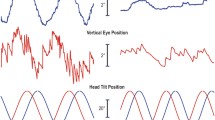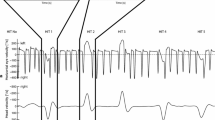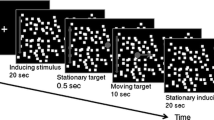Summary
1) In the alert cat, nystagmus induced by off-vertical axis rotation (OVAR) was recorded following steps in head velocity or ramps of velocity at constant acceleration below canal threshold. Dependence of nystagmus characteristics on tilt angle of rotation axis and head velocity was studied. Similar results were obtained with both types of stimulation. 2) Mean and modulation amplitude of horizontal eye velocity increased with tilt angle in the range 0–30 degrees. 3) Both variables increased also with head velocity, but with different trends, probably because they are set by different mechanisms. When head rotational velocity was increased above 80°/s, mean eye velocity progressively decreased to zero. 4) In spite of variations from one animal to another, some regularity was observed in the phase of eye velocity modulation. In several cases, a reduction in phase lead of eye velocity with respect to conventional origin of phases (nose-down position) was observed when head velocity increased. 5) Time constant of post-OVAR nystagmus decreased with the tilt angle of the rotation axis from gravity, but not with the orientation of the head with respect to rotation axis. 6) The results could be accounted for by a general equation describing the vestibulo-ocular reflex, provided that estimates of kinematic variables of head movement (head rotational and translational velocities), and visual target distance could be computed by the Central Nervous System.
Similar content being viewed by others
References
Benson AJ (1974) The perception of body orientation relative to a rotating linear acceleration vector. Fortschr Zool 23: 264–274
Benson AJ, Bodin MA (1966) Interaction of linear and angular accelerations on vestibular receptors in man. Aerosp Med 37: 144–154
Bodin MA (1968) The effect of gravity on human vestibular responses during rotation in pitch. J Physiol (Lond) 196: 74–75
Cohen B (1977) Qualitative analysis of the velocity characteristics of optokinetic nystagmus and optokinetic after-nystagmus. J Physiol (Lond) 270: 321–344
Cohen B, Matsuo V, Raphan T (1977) Quantitative analysis of the velocity characteristics of optokinetic nystagmus and optokinetic after-nystagmus. J Physiol (Lond) 270: 321–344
Cohen B, Suzuki J, Raphan T(1983) Role of the otolith organs in generation of horizontal nystagmus; effects of selective labyrinthine lesions. Brain Res 276: 159–164
Collins WE, Guedry FE (1967) Duration of angular acceleration and ocular nystagmus from cat and man. I. Responses from the lateral and the vertical canals to two stimulus durations. Acta Otolaryngol (Stockh) 64: 373–387
Collins WE, Schroeder DJ, Rice N, Mertens RA, Kranz G (1970) Some characteristic of optokinetic eye-movement patterns: a comparative study. Aerosp Med 41: 1251–1262
Correia MJ, Guedry FE (1966) Modification of vestibular response as a function of the rate of rotation about an earth horizontal axis. Acta Otolaryngol (Stockh) 62: 297–308
Correia MJ, Money KE (1970) The effect of blockage of all six semi-circular canal ducts on nystagmus produced by linear acceleration in the cat. Acta Otolaryngol (Stockh) 69: 7–16
Darlot C, Lopez-Barneo J, Tracey D (1981) Asymmetry of vertical vestibular nystagmus in the cat. Exp Brain Res 41: 420–426
Darlot C, Denise P, Droulez J (1985) Modulation by horizontal eye position of the vestibulo-collic reflex induced by tilting in the frontal plane in the alert cat. Exp Brain Res 58: 510–519
Darlot C, Denise P, Cohen B, Berthoz A (1988) Eye movements induced by off-vertical axis rotation at small angles of tilt in man. Exp Brain Res (in press)
Evinger JR, Fuchs AF (1978) Saccadic smooth pursuit and optokinetic eye movements of the trained cat. J Physiol (Lond) 285: 209–229
Goldberg JM, Fernández C (1981) Physiological mechanisms of the nystagmus produced in the squirrel monkey by rotations about an earth-horizontal axis. Ann NY Acad Sci 374: 40–43
Goldberg JM, Fernández C (1982) Eye movements and vestibular nerve response produced in the squirrel monkey by rotations about an earth-horizontal axis. Exp Brain Res 46: 393–402
Guedry FE (1965) Orientation of the rotation axis relative to gravity: its influence on nystagmus and the sense of rotation. Acta Otolaryngol (Stockh) 60: 30–48
Harris LR (1986) Adaptation of the vestibulo-ocular reflex does not affect the response to off-vertical axis rotation in the cat. J Physiol (Lond) 382: 78
Harris LR (1987) Vestibular and optokinetic eye movements evoked in the cat by rotation about a tilted axis. Exp Brain Res 66: 522–532
Harris LR, Barnes GB (1985) The orientation of vestibular nystagmus is modified by head tilt. Int. meeting of Barany Society, Ann Arbor, Michigan (in press).
Igarashi M, Takahashi M, Kubo T, Alford BR, Wright WK (1980) Effect of off-vertical tilt and macular ablation on postrotatory nystagmus in the squirrel monkey. Acta Otolaryngol (Stockh) 90: 93–99
Janeke JB (1968) On nystagmus and otoliths. A vestibular study of responses as provoked by a cephalo-caudal horizontal axial Doctoral dissertation. University of Amsterdam
Keller EL, Precht W (1979) Adaptive modification on central vestibular neurons in response to visual stimulation through reversing prisms. J Neurophysiol 42: 896–911
King WM, Leigh RJ (1982) Physiology of vertical gaze. In: Lennerstrand G, Zee DS, Keller EL (eds) Functional basis of ocular motility disorders. Pergamon Press, Oxford, New York, pp 267–276
Landers PH, Taylor A (1975) Transfer function analysis of the vestibulo-ocular reflex in the conscious cat. In: Lennerstrand G, Bach-y-Rita P (eds) Basic mechanisms of ocular motility and their clinical implications. Pergamon Press, Oxford, pp 505–508
Matsuo V, Cohen B, Raphan T, de Jong V, Henn V (1979) Asymmetric velocity storage for upward and downward nystagmus. Brain Res 176: 159–164
Matsuo V, Cohen B (1984) Vertical optokinetic nystagmus and vestibular nystagmus in the monkey: updown asymmetry and effects of gravity. Exp Brain Res 53: 197–216
Mayne R (1974) A system concept of the vestibular organs. In: Kornhuber HH (ed) Handbook of sensory physiology, Vol VI/2. The vestibular system. Springer, New York, pp 493–580
Money KE, Scott JW (1962) Functions of separate sensory receptors of non-auditory labyrinth in the cat. Am J Physiol 202: 1211–1220
Raphan T, Cohen B (1985) Velocity storage and the ocular response to multidimensional vestibular stimuli. In: Berthoz A, Melvill-Jones G (eds) Adaptive mechanisms in gaze control: facts and theories. Elsevier, Amsterdam, pp 123–143
Raphan T, Cohen B, Henn V (1981) Effects of gravity on rotatory nystagmus in monkeys. Ann NY Acad Sci 374: 337–346
Roucoux A, Vidal PP, Veraart C, Crommelinck M, Berthoz A (1982) The relation of neck muscles activity to horizontal eye position in the alert cat. I. Head free. In: Roucoux A, Crommelinck M (eds) Physiological and pathological aspects of eye movements. W. Junk, Den Haag, pp 371–378
Stockwell CW, Turnipseed GT, Guedry FE (1970) Nystagmus responses during rotation about a tilted axis. U.S. Army-Navy joint report no. NAMRL-1129 Pensacola, Fla., Nav. Aerosp. Med. Res. Lab.
Vidal PP, Roucoux A, Berthoz A (1982) Horizontal eye position related activity in neck muscles of the alert cat. Exp Brain Res 46: 448–453
Viirre E, Tweed D, Milner K, Vilis T (1986) A re-examination of the gain of the vestibulo-ocular reflex. J Neurophysiol S6-2: 439–450
Waespe W, Cohen B, Raphan T (1983) Role of the flocculus and paraflocculus in optokinetic nystagmus and visual vestibular interactions: effects of lesions. Exp Brain Res 50: 9–33
Waespe W, Cohen B, Raphan T (1985) Dynamic modification of the vestibulo-ocular reflex by the nodulus and uvula. Science 228: 199–202
Wall C III, Black O (1984) The modulation component of nystagmus during earth-horizontal rotation: relationship with gaze angle. Acta Otolaryngol (Stockh) 97: 193–201
Young, LR, Henn V (1975) Nystagmus induced by pitch and yaw rotation in monkeys. Fortschr Zool 23: 235–246
Author information
Authors and Affiliations
Rights and permissions
About this article
Cite this article
Darlot, C., Denise, P. Nystagmus induced by off-vertical rotation axis in the cat. Exp Brain Res 73, 78–90 (1988). https://doi.org/10.1007/BF00279663
Received:
Revised:
Accepted:
Issue Date:
DOI: https://doi.org/10.1007/BF00279663




